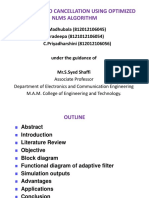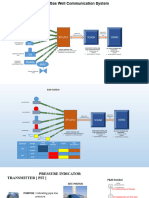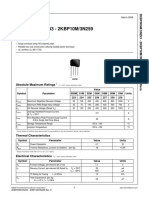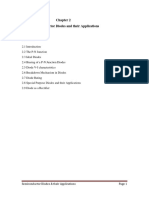Real Time Automated Load Shedding System
Real Time Automated Load Shedding System
Uploaded by
Sangeetha VishwanathCopyright:
Available Formats
Real Time Automated Load Shedding System
Real Time Automated Load Shedding System
Uploaded by
Sangeetha VishwanathOriginal Description:
Original Title
Copyright
Available Formats
Share this document
Did you find this document useful?
Is this content inappropriate?
Copyright:
Available Formats
Real Time Automated Load Shedding System
Real Time Automated Load Shedding System
Uploaded by
Sangeetha VishwanathCopyright:
Available Formats
Real time automated load shedding system and fault detection
1. INTRODUCTION
The power consumption is increasing day by day. Load shedding is a method by power supply board to minimize the consumption of power. With the help of this system the process of load shedding of power lines can be made automatic. The whole process is controlled by the microcontroller 89c51 and the real time clock (RTC) PCF 8563 which runs in real time. Here the user can feed the different timings (ON and OFF) for the different power lines, and then according to the entered timings the microcontroller connects and disconnects the power lines automated load shedding system is achieved through real time. In this system two type of faults namely overload and open line faults can also be identified. Automated load shedding system is achieved through real time. However, these automated solutions lack system operating knowledge and are still best-guess methods which typically result in excessive or sufficient load shedding. A load shedding system can provide faster and optimal load relief by utilizing actual operating conditions.
1.1 Objectives:
The Load Shedding for the power lines is performed Automated and this process is achieved through Real Time. Microprocessor plays a very important role in this project which is operated to transmit load shed commands as an input to the Relay drivers. It is the best method which typically results in efficient Load Shedding and this system can provide faster and most favorable load relief by utilizing actual operating conditions and knowledge. Turn ON and OFF for the Load Lines can be provided simultaneously at the same time or it can be done at different time.
1.2 Material used:
8051/80c51 Microcontroller, Real Time Clock-PCF 8563, Serial EEPROM, 16*2 LCD, 4*4 Matrixes, Keyboard, Relays.
1.3 Software:
Kiel micro vision.
Dept. of E&E, SKIT Bangalore -90 2010-2011 Page 1
Real time automated load shedding system and fault detection
2. FUNCTIONAL BLOCK DIAGRAM
Eeprom 24c32
Real time Clock PCF 8563
MC 89c51
Relay Drivers And Relays
Power LINES
4*4 Matrix Keyboard
CT Hts10p ADC 0809 Signal conditioner
16*2 LCD
Fig 2.1: Block Diagram
Dept. of E&E, SKIT Bangalore -90
2010-2011
Page 2
Real time automated load shedding system and fault detection
3. FUNCTIONAL DESCRIPTION
In this project a real time clock PCF 8563 is used to monitor the time, which can be interfaced with the microcontroller and it runs in 24 hour format. So on power up first we have to initialize RTC by entering the present time in the form of Hr: Min: Sec and date in the form of Date/month/Year and weekday, once the informations entire are entered, then RTC will start running in real time.
If we want to control the lines according to the time, then user has to enter the ON and OFF time for each and every lines which will be stored in the microcontroller memory, then microcontroller reads the time from the RTC and will be checking with the entered timings, if any one of the ON or Off time is matched with the present timing then the controller switches ON or Off particular relay to connect or disconnect the particular line.
And also one line is monitored by extracting the current signal through it using the CT HTS10p then it is processed and digitized, then according to the digital signal related to the current signal the microcontroller will come to know that the line is opened or overloaded.
3.1 Current Processing section
Once the mains is connected the loads, then the loads start drawing current, this current taken by the loads is extracted with the help of current transducer HTS 10 P which is connected in series with the phase of the AC mains.
The output of the transducer is a signal of very low voltage (will be in terms of mille volts), which is amplified in two stages using lm 348 amplifier with the gain of 40. Then the amplified voltage is rectified using diode in 4148 and the rectified DC voltage of current signal is applied to the first channel of ADC 0809.
Dept. of E&E, SKIT Bangalore -90
2010-2011
Page 3
Real time automated load shedding system and fault detection
3.2 Analog to Digital Converter (ADC 0809)
ADC 0809 is used to convert the analog input signal to digital value when start of conversion signal is given from microcontroller. This value varies according to the load; the digital value is read from one of the port of the microcontroller.
As the model is turned on, controller will wait for the key press. When the key is pressed load will be turned ON. The controller will then start calculating the units. The available voltage is measured and displayed on the LCD.
Dept. of E&E, SKIT Bangalore -90
2010-2011
Page 4
Real time automated load shedding system and fault detection
4. CIRCUIT DIAGRAM AND ITS REALIZATION
4.1 Power supply circuit
+12 /-12 Volts 500 mA regulated power supply
In mains-supplied electronic systems the AC input voltage must be converted into a DC voltage with the right value and degree of stabilization. Figures below shows the simplest rectifier, filter and stabilization circuits. In these basic configurations the peak voltage across the load is equal to the peak value of the AC voltage supplied by the transformers secondary Winding. For most applications the output ripple produced by these circuits is too high. If a filter capacitor is added after the rectifier diodes The output voltage waveform is improved considerably. The Figure in the circuit uses a center-tapped transformer with four rectifier diodes
Single phase AC voltage is stepped down from 230V ac to 15V AC. Using a bridge rectifier, 15V AC supply is rectified and filtered, passed through a linear regulator circuit to get a regulated power supply. With the help of IC 7812 and 7912 linear regulators +-12 V regulated supply is derived.
Dept. of E&E, SKIT Bangalore -90
2010-2011
Page 5
Real time automated load shedding system and fault detection
Fig 4.1.1: +12/-12 volts 500ma regulated power supply circuit
Transformer selected is 15-0-15 volts, 1 Amps. Peak Secondary voltage = 1.4142 * 15 = 21.21 Volts Filter capacitor voltage = 21.21 0.7-0.7 = 19.81 volts The value of the capacitor is selected in such a way that for the designed circuit the ripple of the rectified , filtered dc voltage should have a minimum value; C = 5 I / FV for a 10% ripple factor. Where I= load current F= Supply frequency, V= Peak secondary supply voltage of transformer The ripple factor must be as much as low as possible for the proper operation of the circuit. Capacitor C2 is used as High frequency filter, bypass all high frequency signals coming on the DCline. IC 7812 is a +ve voltage regulator needs an input voltage minimum of 12+ 2.5 = 14.5 volts for providing regulated voltage.
Dept. of E&E, SKIT Bangalore -90
2010-2011
Page 6
Real time automated load shedding system and fault detection
Similarly IC 7912 is a -ve voltage regulator needs an input voltage minimum of 12 + 2.5 = 14.5 volts for providing regulated voltage. IC 7805 is a positive voltage regulator gives a related output voltage of 5 Volts which needs a minimum voltage of 5+2.5 = 7.5 volts as minimum input for its operations. 5Volts, 1.0 Amps Regulated DC Power supply The +5Volts regulated DC power supply is derived from another regulator IC 7805 whose input voltage is unregulated DC supply of around 15V DC. Unregulated DC voltage is applied to the input pin of the regulator IC after filtering AC component through capacitors. The regulator IC keeps the line and load regulation with in 1% of throughout voltage and once again the capacitors are used to reduce the ac components on the output voltage.
Capacitors C2 and C4 are used for high frequency noise rejection. Capacitor C3 improves the load regulation.
Fig 4.1.2: 5 volts, 1.0 amps regulated power supply circuit Dept. of E&E, SKIT Bangalore -90 2010-2011 Page 7
Real time automated load shedding system and fault detection
4.2 Hall effect Current Transducer and its signal conditioning circuit
The output of the sensor is linearly proportional to the current in the A Hall Effect
Current Sensor is a current transformer, which utilizes the Hall Effect. This effect was first observed by Edwin Hall in 1879. He conducted experiments on gold foils wherein he monitored the current flowing from the top to the bottom of a thin rectangular strip. He found that, in the presence of a magnetic field perpendicular to the strip, the electrons were deflected to one side of the gold foil. This caused an excess electrical charge build up, which gave rise to a voltage difference across the right and left side of the foil. This electric field (voltage difference), which is perpendicular to both the magnetic field and the current flow, is called the Hall Voltage. In the absence of a magnetic field, or in the presence of a magnetic field parallel to the strip, there was no voltage difference between the right and left side of the strip.
Fig 4.2.1: Magnetic field showing Hall voltage direction
Dept. of E&E, SKIT Bangalore -90
2010-2011
Page 8
Real time automated load shedding system and fault detection
4.2.1 Theory of Hall Effect
The Hall Effect can be explained by the Lorentz force principle. When a charge moves in a direction perpendicular to an applied magnetic field, it experiences a force defined by the Lorentz Law. The direction of this Force is perpendicular to the direction of propagation of the charge and that of the external magnetic field.
4.2.2 Operation of Hall Current Sensor
A Hall Current Sensor utilizes the principle of the Hall Effect to detect the current levels. These sensors monitor the gauss level created by a flow of current; they do not measure the actual current flow. The current being measured (through the primary conductor) is passed through a flux-collecting core (which is generally a slotted torpid) that concentrates the magnetic field on the Hall element. The Hall element is a piece of semiconductor material, which produces the Hall voltage proportional to the current flow. The Hall voltage is a low level signal, so generally a low noise high gain amplifier is used to regulate the output of the Hall element. The Hall Element along with the evaluation and regulation circuitry is generally fabricated into a single IC (Integrated Circuit).
Figure shows an example of the output waveform of these sensors. These sensors are radiometric; where the output voltage of the sensor is half that of the supply voltage, when the current in the primary conductor is zero. This voltage is called the quiescent voltage (Vq). When the current flows in the positive direction then the output voltage is greater than Vq, when the current flow reverses, the output voltage is leads than Vq. Saturation occurs when the current exceeds the rating of the sensor.
Dept. of E&E, SKIT Bangalore -90
2010-2011
Page 9
Real time automated load shedding system and fault detection
Fig 4.2.2.1: output waveform of current sensor
In the below figure the voltage generated Vo across the width of the flat, rectangular conductor is directly proportional to both the magnitude of the current through it and the strength of the magnetic field.
Fig 4.2.2.2: Circuit diagram showing relationship between generated voltage Vo and current
Dept. of E&E, SKIT Bangalore -90
2010-2011
Page 10
Real time automated load shedding system and fault detection
It makes sense then that if we were to build a device using a Hall-effect sensor where the current through the conductor was pushed by AC voltage from an external circuit and the magnetic field was set up by a pair or wire coils energized by the current of the AC power circuit, the Hall voltage would be in direct proportion to the multiple of circuit current and voltage. The below figure shows the configuration of a closed loop sensor. Here, the output of the Hall IC is amplified and driven through a coil wound around the core. This secondary current, Is, creates a secondary magnetic field in the core. The magnetic flux from the secondary coil is exactly opposite to that generated by the primary conductor and this result in the cancellation of the magnetic flux in the core. The current through the secondary coil is driven through a resistor to measure a voltage that is proportional to the input current Ip.
Fig 4.2.2.3: Closed loop sensor
The selected Hall IC has a quiescent voltage, Voq = 2.5 V which is typically half the supply voltage. It has a sensitivity of 4mV/G. The range of the output voltage for the selected Hall IC is 0.25 V to 4.75 V.
Dept. of E&E, SKIT Bangalore -90
2010-2011
Page 11
Real time automated load shedding system and fault detection
Based on the sensitivity rating and the output voltage we can safely estimate that the IC can sense a flux of 500 G. The selection of the core is based on the size of the primary conductor or the dimension requirements if any.
In the application, a 5Amps Hall effect current transducer is used for reference. The hall sensor operates with a supply voltage of 5 voltages and gives a DC voltage of 2.5Volts for zero current. Since the hall sensor output voltage is 200mv/Amps, voltage developed in the transducer is first amplified, rectified filtered and offset compensated to use it for further application.
Fig 4.2.2.4 Hall current transducer and amplifier circuit
Dept. of E&E, SKIT Bangalore -90
2010-2011
Page 12
Real time automated load shedding system and fault detection
5. SIGNAL CONDITIONING CIRCUIT
The primary and secondary currents of the power transformer are passed through current transformers then transformed to voltage signals by using Hall Effect current transducer as shown in figure. The primary and secondary signals are passed through two buffered, and amplified such that the signals are not distorted because of the loading from subsequent stages .
SW1
SW2
SW3
SW4
SW5
SW6
SW7
SW8 +5V +5V R1 R
1 2 3 R2 R
16X2 LCD
4 5 6 7 8 9 1011121314
16 15
SW9
SW10
SW11
SW12
+5V U1 40 31 5 6 7 21 22 23 24 25 26 27 28 J1 10 11 12 13 14 15 16 17 29 CON8 1 2 3 4 5 6 7 8
SW13
SW14
SW15
SW16 39 38 37 36 35 34 33 32 1 2 3 4 24C32 U2 VCC SCL A2 GND SDA 5 +5V SW17 8 8 6 C1 1 19 +5V
C1
C2
+5V U1 PCF8563 1 8 2 7 3 6 Y1 5
1 2 3 4
A0 A1
VCC EA/VPP P1.4 P1.5 P0.0/AD0 P1.6 P0.1/AD1 P2.0/A8 P0.2/AD2 P2.1/A9 P0.3/AD3 P2.2/A10 P0.4/AD4 P2.3/A11 P0.5/AD5 P2.4/A12 P0.6/AD6 P2.5/A13 P0.7/AD7 P2.6/A14 P2.7/A15 P1.0 P1.1 P1.2 P1.3 P3.0/RXD P3.1/TXD P3.2/INT0 P1.7 P3.3/INT1 P3.4/T0 P3.5/T1 P3.6/WR XTAL1 P3.7/RD PSEN
230V AC K1 VCC 3 4 5 LOAD 1 2 RELAY SPDT R1 2 from MC RESISTOR 3 1 Q1 BC548
CAP NP C2 2
Y1 AT89C51 CRYSTAL 18 XTAL2 9 RST GND
1 SW PUSHBUTTON
C3 CAP NP CAPACITOR R3 R
ALE/PROG 20
30
Relay driver ckt
Fig 5.1: Signal conditioning circuit
Dept. of E&E, SKIT Bangalore -90
2010-2011
Page 13
Real time automated load shedding system and fault detection
Operation
In this project a Real time clock PCF 8563 is used to monitor the time which can be interfaced with the microcontroller and it runs in 24 hours format. So, on power up first we have to initialize RTC by entering the present time in the form of Hr: Min: Sec and date in the form of Date/month/Year and weekday. Once all the information is entered, the RTC will start running in real time.
If we want to control the load lines according to the time, then user has to enter the ON and OFF time for each and every line which will be stored in the microcontroller memory. Then Microcontroller reads the time from the RTC and will be checking with the entered timings. If any one of the ON or OFF time is matched with the present timings then the controller switches ON or OFF the particular relay to connect or disconnect the particular line.
Here Relay driver is used to drive the relay connected across the power lines and they are switched ON and OFF to connect and disconnect the loads from the power lines according to entered ON and OFF time. A relay is an electro-magnetic switch which is useful if you want to use a low Voltage circuit to switch ON and OFF a light bulb (or anything else) connected to the 220V mains supply.
Dept. of E&E, SKIT Bangalore -90
2010-2011
Page 14
Real time automated load shedding system and fault detection
6. HARDWARE
6.1 Power Supply
Main building block of any electronic system is the power supply to provide required power for their operation. For the microcontroller, audio amplifier, keyboard, edge connector +5V, required. And for driving the motor +12V Is required. The power supply provides regulated output voltage of +5V, and non regulated output voltage +12V. Three terminal IC 7805 meets the requirement of +5V regulated. The secondary voltage from the main transformer is rectified by diodes D1-D4 and filtered by capacitor C1. This unregulated dc voltage is supplied to input pin of regulator IC. C2 is an input bypass capacitor and C3 is to improve ripple rejection. The IC used are fixed regulator with internal short circuit current limiting and thermal shut down capability
Fig 7.1.1: Power supply circuit
Dept. of E&E, SKIT Bangalore -90
2010-2011
Page 15
Real time automated load shedding system and fault detection
6.2 RTC PCF 8563
Description The PCF 8563 is a CMOS real-time clock/calendar optimized for low power consumption. A programmable clock output, interrupt output and voltage-low detector are also provided. All address and data are transferred serially via a two-line bi-directional I2Cbus. Maximum bus speed is 400 kbits/s. the built-in word address register is incremented automatically after each written or read data byte. Features Provides year, month, day, weekday, hours, minutes and seconds based on 32.768 kHz quartz crystal. Century flag Wide operating supply voltage range: 1.0 to 5.5V Low back-up current; typical 0.25uA at VDD=3.0V and Tamb =25C 400kHz two-wire I2C-bus interface(at VDD=1.8 t0 5.5V) Programmable clock output for peripheral devices: 32.768 kHz, 1024 Hz, 32 Hz and 1 Hz. Alarm and timer functions Voltage-low Detector Integrated oscillator capacitor Internal power-on reset I2C-bus slave address: read A3H; write A2H Open drain interrupt pin.
Applications Mobile telephones Portable instruments Fax machines Battery powered products.
Dept. of E&E, SKIT Bangalore -90
2010-2011
Page 16
Real time automated load shedding system and fault detection
Pin Diagram
OSC1 OSC0 INT VSS
1 2 3 4
P C F 8 5 6 3
8 7 6 5
VDD CLKOUT SCL SDA
Fig 7.2.1: Pin diagram of RTC PCF 8563
Functional description The PCF 8563 contains sixteen 8-bit registers with an auto-incrementing address register, an on-chip 32.768 kHz oscillator with an integrated capacitor, a frequency divider which provides the source clock for the Real-time Clock (RTC), a programmable clock output, a timer, an alarm, a voltage-low detector and a 400 kHz I2C-bus Interface.
All 16 registers are designed as addressable 8-bit parallel registers although not all bits are implemented. The first two registers (memory address 00H and 01) are used as control and/or status registers. The memory addresses 02H through 08H are used as counters for the clock function (Seconds up to year counters). Address locations 09H through 0CH contain alarm registers which define the conditions for an alarm. Address 0DH controls the CLKOUT output frequency. 0EH and 0FH are the timer control and timer registers, respectively.
The Seconds, Minutes, Hours, Days, Months, Years as well as the Minute alarm, Hour alarm and day alarm registers are all coded in BCD format. The Weekdays and Weekday alarm register are not coded in BCD format.
When one of the RTC registers is read the contents of all counters are frozen. Therefore, faulty reading of the clock/calendar during a carry condition is prevented.
Dept. of E&E, SKIT Bangalore -90
2010-2011
Page 17
Real time automated load shedding system and fault detection
6.3 Liquid Crystal Display (LCD) module
Frequently a AT89C51 program must interact with the outside world using input and output devices that devices that communicate directly with a human being. One of the most common output devices used is a LCD. Some common LCDs are 16x2 and 20x2 displays, which mean 16 characters per 2 line and 20 characters per lines, respectively. Fortunately. Standards exist which allow us to communicate with vast majority of LCD. The Standard is referred to as HD44780U, which refer to the controller chip, which receivers data from microcontroller and communicates directly with LCD. HD44780U The 44780 standard requires 3 control lines as 4 or 8 1/0 lines for the data bus the user may select whether the LCD is to operate with 4-bit data bus or 8-data bus. The 3 control lines are EN, RS and RW. The EN line is called called Enable. This control line is used to tell LCD that we are sending it Data. To send data the, program should first send High in this line and then set the other two control line and put data on the data bus. When other lines are ready, EN should be made LOW. The RS line is Register selector line . when RS is LOW , the data is to be treated as a command or special instruction (such as CLEAR SCREEN, ETC). When RS is HIGH, the data being sent is text data that should be displayed on the screen. The RW line is read/write control line. When it is LOW, the information on data bus is being written to LCD. When RW is HIGH, the program is effectively querying the LCD with the instruction Get LCD status. A more robust method is to use GET LCD STATUS command to determine if the LCD is the last really use the LCD, must initialize and configure it. This is accomplished by sending a number of instructions to the LCD. The first instruction will be to specify whether we are using 4 or 8- line data bus. Sending a 38h command to the LCD dose this. Before we send the command the RS line should be made low. We then send the 0Eh command to turn the LCD ON. Lastly we send the 06h command so that every time we send a character the cursor automatically moves right. NOTE: the LCD can be cleared using the 01h command.
Dept. of E&E, SKIT Bangalore -90
2010-2011
Page 18
Real time automated load shedding system and fault detection
CURSOR POSITIONING The 44780 contain a certain amount of memory, which is assigned to display. All text we write to 44780 is stored in this memory, and the 44780 subsequently reads this memory to display the text on LCD itself. This memory maps is shown below. DISPLAY In the above memory map, area up to 0F and 4F is the visible display. As one can see, it measures 16 characters per 2 lines. The numbers in each box in memory address that corresponds to that on screen. Thus the Set Cursor Position instruction 80h tell the LCD to position the cursor. Adding the cursor position to 80h does these sets the cursor to the required position on the screen.
PIN Assignment
PIN NO. 1 2 3 4 5 6 7 8 9 10 11 12 13 14 15 16
SYMBOL Vss VDD V0 RS R/W E DBO DB1 DB2 DB3 DB4 DB5 DB6 DB7 LED-(K) LED-(A)
Dept. of E&E, SKIT Bangalore -90
2010-2011
Page 19
Real time automated load shedding system and fault detection
6.4 Interfacing keyboard
A matrix keyboard is a commonly used input device when more than eight keys are necessary, rather than a row of keys as illustrated. A matrix keyboard reduces the number of connections, thus the number of interfacing devices required. For example, a keyboard with 16 keys, arranged in a 4*4 matrix requires eight lines from the Microcontroller to make all the connections instead of 16 lines if the keys are connected in a linear format. When a key is pressed, it shorts one row and column; otherwise, the row and the column do not have any connection. The interfacing of a matrix keyboard requires two ports; one output port and the input port. Rows are connected to the output port, and the columns are connected to the input port. They are capable of interfacing a matrix keyboard as large as 64 keys in eight columns and eight rows. In our project we are using 4*3 matrix keyboard of 12 keys. In which columns are connected to port 2 [P2] and rows are connected to port 0 [P0].
Key sensing logic Initially all the column lines will be in high state and each rows are grounded by making the row port lines low one by one. If we are in say first row it will check whether any key is pressed by reading the column port. If any one of the first row is pressed then the particular column will get low level if in the first row then the column number which gets the low signal will be the key number. For example if we start the column number from zero then the first key identified as number zero. If the none of the key is pressed in row 1 then controller will ground the next row in this row .If any key is pressed it will identify the column number and adds number 4 once to get exact to get exact key number if it is in the row 3 it add number 4 two times to the column number to get the correct key.
Dept. of E&E, SKIT Bangalore -90
2010-2011
Page 20
Real time automated load shedding system and fault detection
Interfacing keyboard
Fig 7.4.1: Interfacing keyboard
6.5 Relay Driver
5V VCC 12V VCC
R1 1 From 10 k Micro Controller Q1 SL 100
RELAY SPDT 5 NC 3 Common 4 1 NO 2
230 AC
VALVE
AC Load
BC 548
GND
GND
Fig 7.5.1: Relay driver
Dept. of E&E, SKIT Bangalore -90
2010-2011
Page 21
Real time automated load shedding system and fault detection
Here relay driver is used to drive the relays connected across the power lines, and they are switched ON and Off to connect and disconnect the loads from the power lines according to the entered ON and Off time.
6.6 Serial EEPROM
Features Low power CMOS technology o maximum write current 3 ma at 5.5v o maximum read current 400micro amps at 5.5v o Standby current 100na typical at 5.5v 2-write serial interface bus, I2C compatible Cascadable for up to eight devices Self-timed ERASE/WRITE cycle 64-byte page-write mode available 5ms max write protect for entire array Hardware write protect for entire array Schmitt trigger inputs for noise suppression 100,000 erase/write cycles guaranteed Electrostatic discharge protection>4000v Data relation> 200 years 8-pins PDIP and SOIC (208ml) packages Temperature ranges: o -Industrial (I) -400 c to +850 c o -Automotive (E) - 400 c to +1250 c Description The Microchip Technology Inc. 24AA256/24LC256 (24x256*) is a 32k x8 (256k bit) Serial Electrically Erasable PROM, capable of operation across a board voltage range (1.8v to 5.5v). it has been developed for advanced, low power applications such as personal communications or data acquision. This device also has a page-write capability of up to 64 bytes of data. This device is capable of both random and sequential reads allow up to 256k
Dept. of E&E, SKIT Bangalore -90 2010-2011 Page 22
Real time automated load shedding system and fault detection
boundary. Functional address lines allow up to eight devices on the same bus, for up to 2 Mbit address space. This device is available in the standard 8-pin plastic DIP, and 8-pin SOIC (208 mil) packages.
PIN Descriptions
Fig 7.6.1: Pin description of serial EEPROM
A0,A1,A2 Chip are Address Inputs The A0,A1,A2 inputs are used by the 24x256 for multiple device operation. The levels on these inputs are compared with the corresponding bits in the slave address .The chip is selected if the compare is true. Up to eight devices may be connected to the same bus by using different chip is select bit combinations. If left unconnected, these inputs will be pulled down internally to Vss. SDA Serial Data This is a bi-directional pin used to transfer addresses and data into and data out of the device. It is an open drain terminal, therefore, the SDA bus requires a pull up resistor to Vcc (typical 10 k ohm for 100 khz, 2k ohm for 400 khz)
Dept. of E&E, SKIT Bangalore -90
2010-2011
Page 23
Real time automated load shedding system and fault detection
SCL serial clock This input is used to synchronize the data transfer from and to the device. WP This pin can be connected to either Vss, Vcc or left floating. An internal pull-down on this pin will keep the device in the unprotected state if left floating. If tied to Vss or left floating, normal memory operation is enabled (read/write the memory 0000-7FFF). If tied to Vcc, WRITE operations are inhibited. Read operation as are not affected. Functional description The 24xx256 support a bi-directional 2-write bus and data transmission protocol. A device that sends data onto the bus is defined as a transmitter, and a device receiving data as a receiver. The bus must be controlled by a master device which generates the serial clock (SCL), controls the bus access, and generates the START and STOP conditions while the 24xx256 works as a slave. Both master and slave can operate as a transmitter or receiver, but the master device determines which mode is activated. Bus characteristics The following bus protocol has been defined: Data transfer may be initiated only when the bus is not busy. During data transfer, the data line must remainstable whenever the clock line-is HIGH/ changes in the data line while the clock line is high will be interpreted as a START or STOP condition. Accordingly, the following bus conditions have been defined. Bus not Busy (A) Both data and clock lines remains HIGH> Start Data Transfer(B) A HIGH to LOW, transmission of the SDA line while the clock (SCL) is high determines START condition. All commands must be preceded by a START condition. Data Valid (D) The state of the data represents valid data when, after a START condition, the data line is stable for the duration of the HIGH period of the clock signal.
Dept. of E&E, SKIT Bangalore -90
2010-2011
Page 24
Real time automated load shedding system and fault detection
7. FLOW CHART
start
Initialise RTC
Yes
Is req to set the present time ?
No
Is req to enter the timings for ON and OFF?
Enter different ON and OFF timings for different lines
Yesy
Yes
Record all entered timings in EEPROM
Read the present time from RTC
No
No Yes
Display Line open
Is time matched with any ON and OFF
Is line open ?
time ?
Yes
Switch ON or Switch OFF the corresponding time matched line
No
Is line over loaded
Yes
Display Over load
No
Fig 8.1: Flow chart
Dept. of E&E, SKIT Bangalore -90
2010-2011
Page 25
Real time automated load shedding system and fault detection
8. ADVANTAGES, DISADVANTAGES AND APPLICATIONS
Advantages Load shedding is made automated and operation can be controlled.
Simple circuit formation. No operation is required for the full 24 hours a day. Once the time is fed for load shedding, the system can operate independently. Requires less maintenance. Load lines can be turned ON /OFF simultaneously at the same time or at different time. The system is secured.
Disadvantages
Since Microcontroller controls the whole system, if any fault occurs in it the whole system fails.
Applications
To provide automated load shedding for the power lines. Can be used in Industries for automation purposes.
Dept. of E&E, SKIT Bangalore -90
2010-2011
Page 26
Real time automated load shedding system and fault detection
9. RESULT
The load shedding can be done according to time. Can maintain time limit for load shedding. Turn ON and OFF the load simultaneously at the same time Turn ON and OFF the load at the different time.
TEST RESULT STATION
STATION 1 STATION 2 STATION 3 STATION 4 STATION 1 STATION 3 STATION 4 STATION 4
DATE
02/05/2011 02/05/2011 03/05/2011 03/05/2011 05/05/2011 05/05/2011 07/05/2011 07/05/2011
DAY
MONDAY MONDAY TUESDAY TUESDAY THURSDAY THURSDAY SATURDAY SATURDAY
OFF TIME
12:30:22 13:15:15 10:30:30 09:15:00 12:24:10 15:02:00 14:09:22 14:30:00
ON TIME
12:50:15 13:30:30 10:55:55 09:59:00 12:35:45 15:05:44 14:10:30 14:33:26
STATUS
SUCCESSFUL SUCCESSFUL SUCCESSFUL SUCCESSFUL SUCCESSFUL SUCCESSFUL FAULT DISPLAYED (OVER LOAD) FAULT DISPLAYED (OPEN LINE)
Dept. of E&E, SKIT Bangalore -90
2010-2011
Page 27
Real time automated load shedding system and fault detection
10. CONCLUSION
Load shedding serves as the ultimate guard that protects the power system from a disturbance-induced collapse. Since we are operating A.C power lines, we should not keep any line open. We can conclude that, with the help of this system the load shedding for the power lines can be made Automatic according to the entered timings for different areas along with fault analysis.
Scope for Future Work
In this project the load shedding is mainly by using Microcontroller and in future GSM Modem (Group Special Mobile) can also be added so that this automated operation can be controlled from far away places.
Dept. of E&E, SKIT Bangalore -90
2010-2011
Page 28
You might also like
- Regal Raptor NAC Service Manual PDFDocument55 pagesRegal Raptor NAC Service Manual PDFKrzysztof Jakiś33% (6)
- Power Electronics - K.B Khanchandani PDFDocument1,078 pagesPower Electronics - K.B Khanchandani PDFChaitanya Shah80% (5)
- Multi Level Inverter DocumentationDocument25 pagesMulti Level Inverter Documentationn anushaNo ratings yet
- IOT Based Social Distancing and Monitoring Robot For QueueDocument8 pagesIOT Based Social Distancing and Monitoring Robot For QueueIJRASETPublicationsNo ratings yet
- Acdc1000 11124 & 11226Document34 pagesAcdc1000 11124 & 11226Jaime ArreolaNo ratings yet
- Automatic Rain Operated Wiper SystemDocument20 pagesAutomatic Rain Operated Wiper SystemVinayaga ProjectinstituteNo ratings yet
- Microcontroller Based Radar SystemDocument19 pagesMicrocontroller Based Radar SystemMeet MakwanaNo ratings yet
- Utility Application of Power ElectronicsDocument21 pagesUtility Application of Power ElectronicsTanishqa SahaNo ratings yet
- Gesture Based Message Conveyer For Paralytic Disabled PeopleDocument19 pagesGesture Based Message Conveyer For Paralytic Disabled PeopleDivya DewkatheNo ratings yet
- Automatic Engine Locking System Through Alcohol Detection For Drunken DriversDocument44 pagesAutomatic Engine Locking System Through Alcohol Detection For Drunken Driversyakshithreddy000No ratings yet
- Underwater Communication Using LI-FI Technology: Names of The Students 2. Aviraj Shejawal 3. Dharyashil WaghchaureDocument19 pagesUnderwater Communication Using LI-FI Technology: Names of The Students 2. Aviraj Shejawal 3. Dharyashil WaghchaureSudarshan RautNo ratings yet
- Iot Based Control and Monitoring of Smart Grid and Power Theft Detection by Locating AreaDocument17 pagesIot Based Control and Monitoring of Smart Grid and Power Theft Detection by Locating AreaakashlogicNo ratings yet
- Portable Mobile ChargerDocument11 pagesPortable Mobile ChargerAbirami Mani57% (7)
- Ultrasonic Navigation For Blind With Audio Interface DocumentationDocument55 pagesUltrasonic Navigation For Blind With Audio Interface DocumentationGoutham Raj Mode60% (5)
- Design and Implementation of An Advanced Security System For Farm Protection From Wild AnimalsDocument5 pagesDesign and Implementation of An Advanced Security System For Farm Protection From Wild AnimalsGRD JournalsNo ratings yet
- Echo Cancellation Final PPT NewDocument34 pagesEcho Cancellation Final PPT NewMadhubalaNo ratings yet
- SRSA. Ppt-1Document15 pagesSRSA. Ppt-1Santhoshi RupaNo ratings yet
- Speed Control of A DC Motor Using Hand GestureDocument4 pagesSpeed Control of A DC Motor Using Hand GestureArka Prava LahiriNo ratings yet
- Final Minor ReportDocument39 pagesFinal Minor ReportAman GuptaNo ratings yet
- Diamond Security System in A Museum With Loud 60dB SireN1Document50 pagesDiamond Security System in A Museum With Loud 60dB SireN1Midde ShekarNo ratings yet
- Automatic Drunk and Drive Vehicle Locking Using Without HelmetDocument9 pagesAutomatic Drunk and Drive Vehicle Locking Using Without HelmetPraveen KrishnaNo ratings yet
- Iot Circuit BreakerDocument5 pagesIot Circuit BreakerMadhuri RudravelliNo ratings yet
- Solar Powered Auto Irrigation SystemDocument13 pagesSolar Powered Auto Irrigation Systemlokesh_045No ratings yet
- Pick and Place RobotDocument5 pagesPick and Place RobotAkhilesh MaheshwariNo ratings yet
- Object Sorting Robotic Arm Based On Colour and Shape SensingDocument4 pagesObject Sorting Robotic Arm Based On Colour and Shape Sensingnadeemq_0786No ratings yet
- Automated Height Based Box Sorting System Using PLC: Project OnDocument36 pagesAutomated Height Based Box Sorting System Using PLC: Project OnKetan KundiyaNo ratings yet
- Density Based Traffic Light ControllingDocument39 pagesDensity Based Traffic Light Controllingsantosh426No ratings yet
- Design and Construction of LED Matrix DisplayDocument7 pagesDesign and Construction of LED Matrix DisplayTseren TsekuNo ratings yet
- Password Based Circuit BreakerDocument8 pagesPassword Based Circuit BreakerRakshitha kNo ratings yet
- Home Security SystemDocument88 pagesHome Security Systemmallanna4blogs0% (1)
- Aircraft Hybrid Electric Aircraft MotorsDocument5 pagesAircraft Hybrid Electric Aircraft MotorsAdis Har-yo CahyonoNo ratings yet
- DC-DC Converter To Step Up Input VoltageDocument3 pagesDC-DC Converter To Step Up Input VoltageFawwaaz HoseinNo ratings yet
- SYSC5603 Project Report: Real-Time Acoustic Echo CancellationDocument15 pagesSYSC5603 Project Report: Real-Time Acoustic Echo CancellationqasimalikNo ratings yet
- Plant Disease Detection Using Convolutional Neural NetworkDocument14 pagesPlant Disease Detection Using Convolutional Neural NetworkVaibhav MandhareNo ratings yet
- Voice Controlled Vehicle For Physically Disabled Person: Presentation OnDocument15 pagesVoice Controlled Vehicle For Physically Disabled Person: Presentation OnPooja GNo ratings yet
- Alcohol Detection With Engine Locking (PPT) - 1Document19 pagesAlcohol Detection With Engine Locking (PPT) - 1Chotu Chotu100% (1)
- Ai Project Report PDFDocument54 pagesAi Project Report PDFsai vickyNo ratings yet
- Automatic Car Engine Locking System For Drunken DrivingDocument56 pagesAutomatic Car Engine Locking System For Drunken DrivingsujathaNo ratings yet
- Electric ReportDocument33 pagesElectric ReportAkshay bypNo ratings yet
- A Minor Project Report Submitted To Rajiv Gandhi Prodhyogik Vishwavidyalaya, Bhopal Towards Partial Fulfillment For The Award of The Degree ofDocument53 pagesA Minor Project Report Submitted To Rajiv Gandhi Prodhyogik Vishwavidyalaya, Bhopal Towards Partial Fulfillment For The Award of The Degree ofwahidjaanNo ratings yet
- Password Based Circuit BreakerDocument7 pagesPassword Based Circuit BreakerAnuj TripathiNo ratings yet
- Simulation For Iot Based Smart Traffic Control System For Emergency VehiclesDocument44 pagesSimulation For Iot Based Smart Traffic Control System For Emergency VehiclesJeba JinilNo ratings yet
- Major Project PraveenDocument33 pagesMajor Project PraveenPraveen dewalNo ratings yet
- Project Report FinalDocument60 pagesProject Report Finalaisha singhNo ratings yet
- FINGERPRINT BASED CAR IGNITION SYSTEM 1 To 4Document52 pagesFINGERPRINT BASED CAR IGNITION SYSTEM 1 To 4BAMIGBADE JOSHUANo ratings yet
- AmbulanceDocument19 pagesAmbulanceSampath Kumar Bejgama100% (1)
- Advanced Voting Machine Using Face RecognitionDocument25 pagesAdvanced Voting Machine Using Face Recognitionritu OfficialNo ratings yet
- Automatic Dam Gate Control System With Caution AlarmDocument20 pagesAutomatic Dam Gate Control System With Caution AlarmRam Reddy100% (6)
- 1.protection of Busbar Distribution From Over LoadDocument4 pages1.protection of Busbar Distribution From Over LoadPooja Ban100% (1)
- Embedded Based Industrial Security System With Auto DialerDocument49 pagesEmbedded Based Industrial Security System With Auto DialermdayyubNo ratings yet
- DC Motor CTRL Using Single SwitchDocument44 pagesDC Motor CTRL Using Single SwitchAbhijeet NayakNo ratings yet
- Final PPT (Autosaved)Document34 pagesFinal PPT (Autosaved)KARTHIK.K 18BEC023No ratings yet
- Final Year Project SynopsisDocument5 pagesFinal Year Project SynopsisAshok KumarNo ratings yet
- Design of Intelligent Ambulance and Traffic Control RFDocument12 pagesDesign of Intelligent Ambulance and Traffic Control RFBala GaneshNo ratings yet
- Automatic Fire Control System in Railways 1Document44 pagesAutomatic Fire Control System in Railways 1RAJ50% (2)
- Fingerprint Based Voting MachineDocument62 pagesFingerprint Based Voting MachineNaveen Kumar83% (6)
- "IOT Based Water Pollution Monitoring RC Boat": Prepared byDocument21 pages"IOT Based Water Pollution Monitoring RC Boat": Prepared byMiracle AlignerNo ratings yet
- Active Disturbance Rejection Control for Nonlinear Systems: An IntroductionFrom EverandActive Disturbance Rejection Control for Nonlinear Systems: An IntroductionNo ratings yet
- Ultra Fast Acting Electronic Circuit BreakerDocument55 pagesUltra Fast Acting Electronic Circuit Breakerpandi60% (5)
- Kapasitor MikroDocument5 pagesKapasitor MikroDiki SuryadiNo ratings yet
- A Remote Electricity Billing SystemDocument9 pagesA Remote Electricity Billing SystemHemant PatelNo ratings yet
- Role of Power Electronics in Ev DevelopmentDocument14 pagesRole of Power Electronics in Ev DevelopmentVASALA AJAYKUMAR RGUKT BasarNo ratings yet
- Well Instrument and Communication SystemDocument21 pagesWell Instrument and Communication SystemKiran NairNo ratings yet
- 2n258 PDFDocument3 pages2n258 PDFbilalNo ratings yet
- Enclosure 6150 8kw DATASHEET 28701-FGC1013256Document4 pagesEnclosure 6150 8kw DATASHEET 28701-FGC1013256Leo DuranNo ratings yet
- GSM Module Based Integrative Detection of Open Drainage Over Flow and CurrentDocument91 pagesGSM Module Based Integrative Detection of Open Drainage Over Flow and Currentvijay4vlrNo ratings yet
- SAIL Electronics and Electrical Engineering Objective Type Questions With Answers For PracticeDocument4 pagesSAIL Electronics and Electrical Engineering Objective Type Questions With Answers For Practicebalu56kv100% (1)
- Slua 121Document4 pagesSlua 121Chinedu EgbusiriNo ratings yet
- Laboratory Experiment-3Document10 pagesLaboratory Experiment-3PajayNo ratings yet
- Floyd - A-21Document564 pagesFloyd - A-21Kat Calado50% (2)
- Tutorials in Power ElectronicsDocument66 pagesTutorials in Power ElectronicsAbdullah Al AsikNo ratings yet
- 10-100kVA ATLAS3000 USER MANUAL-UpdatedDocument37 pages10-100kVA ATLAS3000 USER MANUAL-UpdatedAlwyn GeorgeNo ratings yet
- Electrical ConnectionsDocument1 pageElectrical ConnectionsremaldarioNo ratings yet
- Applying Synchronous Condenser For Damping Provision in Converter-Dominated Power SystemDocument10 pagesApplying Synchronous Condenser For Damping Provision in Converter-Dominated Power SystemAndré LuizNo ratings yet
- Load Power Control by Using SCRDocument40 pagesLoad Power Control by Using SCRalthaf hussainNo ratings yet
- Manual MillerDocument44 pagesManual MillerIsai MixiaNo ratings yet
- WEG cfw11 Users Manual 400v Sizes F G and H 10000784107 enDocument116 pagesWEG cfw11 Users Manual 400v Sizes F G and H 10000784107 enRolando Albuquerque MartinsNo ratings yet
- DiodesDocument27 pagesDiodesamanuelfitsum589No ratings yet
- A4954 Datasheet PDFDocument9 pagesA4954 Datasheet PDFJason WuNo ratings yet
- PSU4850ADocument5 pagesPSU4850AJaved hashimNo ratings yet
- Irf8707Pbf-1: Hexfet Power MosfetDocument9 pagesIrf8707Pbf-1: Hexfet Power MosfetPablo LloveraNo ratings yet
- PM4Q (Admzp0da)Document29 pagesPM4Q (Admzp0da)Ricardo Gamez OrtegaNo ratings yet
- Fact Sheet - DPS 2900 - ESAA300-HTB Series - en - Rev01 (W)Document2 pagesFact Sheet - DPS 2900 - ESAA300-HTB Series - en - Rev01 (W)Manuel Torrón FerreiroNo ratings yet
- User Manual: ETP4830-A1 V300R001Document39 pagesUser Manual: ETP4830-A1 V300R001HtourchianNo ratings yet
- Cut 40 Air Plasma Cutter ManualDocument8 pagesCut 40 Air Plasma Cutter ManualAymeric Theyse100% (1)
- NX400 Spec SheetDocument2 pagesNX400 Spec SheetCông ty TNHH Thương mại và Dịch vụ Viễn thông TS&T Việt NamNo ratings yet
- Phy301.Final McqsDocument35 pagesPhy301.Final McqsShahzad Niazi100% (2)
- 5A Adjustable Regulated Power Supply PDFDocument1 page5A Adjustable Regulated Power Supply PDFEdgar AdonisNo ratings yet

























































































